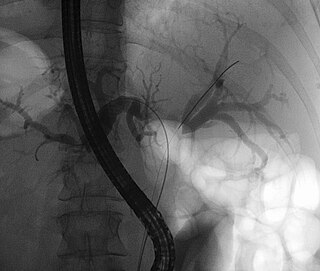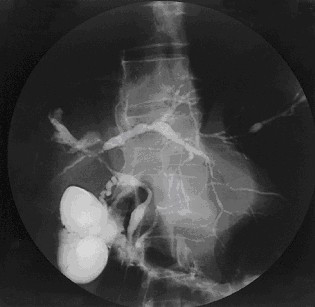This page is based on this
Wikipedia article Text is available under the
CC BY-SA 4.0 license; additional terms may apply.
Images, videos and audio are available under their respective licenses.

Primary biliary cholangitis (PBC), previously known as primary biliary cirrhosis, is an autoimmune disease of the liver. It results from a slow, progressive destruction of the small bile ducts of the liver, causing bile and other toxins to build up in the liver, a condition called cholestasis. Further slow damage to the liver tissue can lead to scarring, fibrosis, and eventually cirrhosis.

A Klatskin tumor is a cholangiocarcinoma occurring at the confluence of the right and left hepatic bile ducts. The disease was named after Gerald Klatskin, who in 1965 described 15 cases and found some characteristics for this type of cholangiocarcinoma

Endoscopic retrograde cholangiopancreatography (ERCP) is a technique that combines the use of endoscopy and fluoroscopy to diagnose and treat certain problems of the biliary or pancreatic ductal systems. Through the endoscope, the physician can see the inside of the stomach and duodenum, and inject a contrast medium into the ducts in the biliary tree and pancreas so they can be seen on radiographs.

Cholangiocarcinoma, also known as bile duct cancer, is a type of cancer that forms in the bile ducts. Symptoms of cholangiocarcinoma may include abdominal pain, yellowish skin, weight loss, generalized itching, and fever. Light colored stool or dark urine may also occur. Other biliary tract cancers include gallbladder cancer and cancer of the ampulla of Vater.

Common bile duct stone, also known as choledocholithiasis, is the presence of gallstones in the common bile duct (CBD). This condition can cause jaundice and liver cell damage. Treatment is by cholecystectomy and endoscopic retrograde cholangiopancreatography (ERCP).

Cholestasis is a condition where bile cannot flow from the liver to the duodenum. The two basic distinctions are an obstructive type of cholestasis where there is a mechanical blockage in the duct system that can occur from a gallstone or malignancy, and metabolic types of cholestasis which are disturbances in bile formation that can occur because of genetic defects or acquired as a side effect of many medications.
Cholangiocytes are the epithelial cells of the bile duct. They are cuboidal epithelium in the small interlobular bile ducts, but become columnar and mucus secreting in larger bile ducts approaching the porta hepatis and the extrahepatic ducts.
Autoimmune pancreatitis is an increasingly recognized type of chronic pancreatitis that can be difficult to distinguish from pancreatic carcinoma but which responds to treatment with corticosteroids, particularly prednisone. There are two categories of AIP: Type 1 and Type 2, each with distinct clinical profiles.
Cholangiosarcoma is a tumor of the connective tissues of the bile ducts.
Charcot's cholangitis triad is the combination of jaundice; fever, usually with rigors; and right upper quadrant abdominal pain. It occurs as a result of ascending cholangitis. When the presentation also includes low blood pressure and mental status changes, it is known as Reynolds' pentad. It is named for Jean-Martin Charcot.

Trepibutone is a drug used for functional gastrointestinal disorders. Trepibutone promotes secretion of the bile and pancreatic juice, and accelerates flaccidity of the smooth muscle in the gastrointestinal tract to lower internal pressure of the gallbladder and bile duct. It improves the symptoms of the bile duct and pancreatic disease. It is usually used for improvement of cramp and bile secretion associated with cholelithiasis, cholecystitis, cholangitis, dyskinesia of the biliary tract or postcholecystectomy syndrome, or pain and gastrointestinal symptoms associated with chronic pancreatitis.

Sclerosis is the stiffening of a structure, usually caused by a replacement of the normal organ-specific tissue with connective tissue. The structure may be said to have undergone sclerotic changes or display sclerotic lesions, which refers to the process of sclerosis. The term is from Greek σκληρός "hard".
Cholestatic pruritus is the sensation of itch due to nearly any liver disease, but the most commonly associated entities are primary biliary cirrhosis, primary sclerosing cholangitis, obstructive choledocholithiasis, carcinoma of the bile duct, cholestasis, and chronic hepatitis C viral infection and other forms of viral hepatitis.
Vanishing bile duct syndrome is a loose collection of diseases which leads to the injury to hepatic bile ducts and eventual ductopenia.
Intercept Pharmaceuticals, Inc. is an American biopharmaceutical company incorporated in 2002, focusing on the development of novel synthetic bile acid analogs to treat chronic liver diseases, such as primary biliary cirrhosis (PBC) now called primary biliary cholangitis, non-alcoholic fatty liver disease, cirrhosis, portal hypertension, primary sclerosing cholangitis and also the intestinal disorder, bile acid diarrhea.
Biliary diseases include gallbladder disease and biliary tract diseases. In 2013 they resulted in 106,000 deaths up from 81,000 deaths in 1990.










